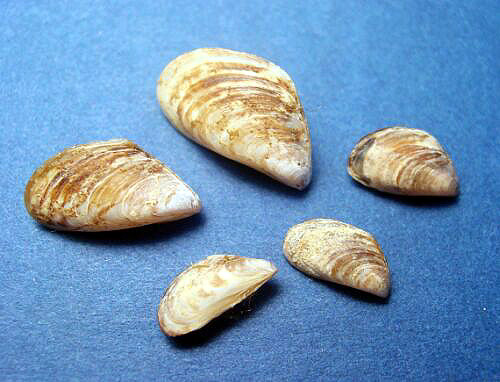The quagga mussel, first discovered in the United States in 1989, is an invasive species that alters the food web by filtering water and removing plankton, according to the U.S. Geological Survey. (Amy Benson/U.S. Geological Survey)
Officials with the Idaho State Department of Agriculture announced Tuesday that they have detected new quagga mussels in the Snake River near Twin Falls.
Tuesday’s announcement arrived almost exactly one year after state officials announced they detected the invasive species in Snake River for the first time in September 2023. In response to first detecting the mussels, state officials used a copper based chemical called Natrix in the Snake River in an effort to kill off the mussels, the Sun previously reported.
Until this most recent detection of quagga mussels, state water sampling was negative for quagga mussels in 2024, the Sun also reported.
“While we are incredibly disappointed to see any confirmations, we know that pest eradication is rarely one and done,” Idaho State Department of Agriculture Director Chanel Tewalt said in a written statement Tuesday. “We have made significant progress, and now we must focus on the next phase of eradication. (The Idaho State Department of Agriculture) and the many partners who have helped in countless ways will continue to push for full eradication.”
The quagga mussels were detected in the Shoshone Falls pool, Pillar Falls and the Twin Falls Reservoir behind the Twin Falls hydroelectric facility, state officials said Tuesday.
Quagga mussels are an invasive, nonnative species that reproduces rapidly. State officials with the Idaho State Department of Agriculture said eradicating the mussels is a priority because they are capable of clogging pipes, which could pose a threat to drinking water, irrigation, agriculture, recreational tourism and hydroelectric energy generation.
In a statement released Tuesday, Idaho Gov. Brad Little said the state is fortunate because of its invasive species programs and state investments in those programs. During the 2024 legislative session, legislators approved $6.6 million in the fiscal year 2025 budget to fight invasive species, the Sun previously reported.
“Idaho had the foresight years ago to start investing in the resources needed to detect and eradicate invasive species, and that investment is paying off,” Little said in a written statement. “I want to thank my partners in the Idaho Legislature for making this happen. With an effective, robust invasive species program in place, we are far better off today than we were even a year ago when quagga mussels were first detected in the Snake River.
“One of our greatest success stories as a state has been the coordinated, rapid response to quagga mussels last fall, but we knew we would be on watch for a period of five years. I have great confidence in the team at the Idaho State Department of Agriculture and their many, many partners to continue to tackle this problem with minimal disruption to the public.”
GET THE MORNING HEADLINES DELIVERED TO YOUR INBOX
Idaho Capital Sun, like Oregon Capital Chronicle, is part of States Newsroom, a nonprofit news network supported by grants and a coalition of donors as a 501c(3) public charity. Idaho Capital Sun maintains editorial independence. Contact Editor Christina Lords for questions: info@idahocapitalsun.com. Follow Idaho Capital Sun on Facebook and X.

